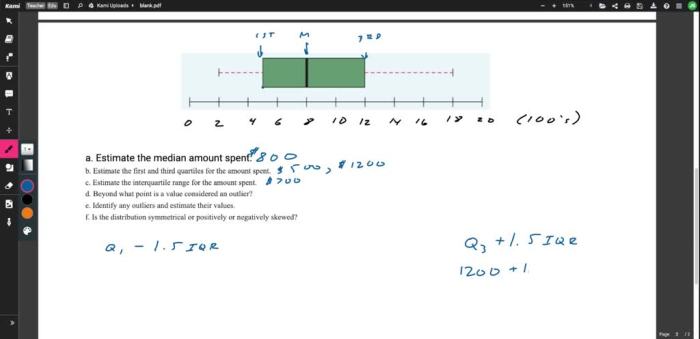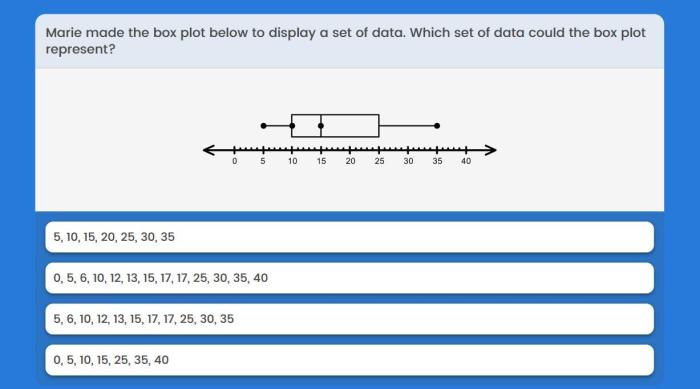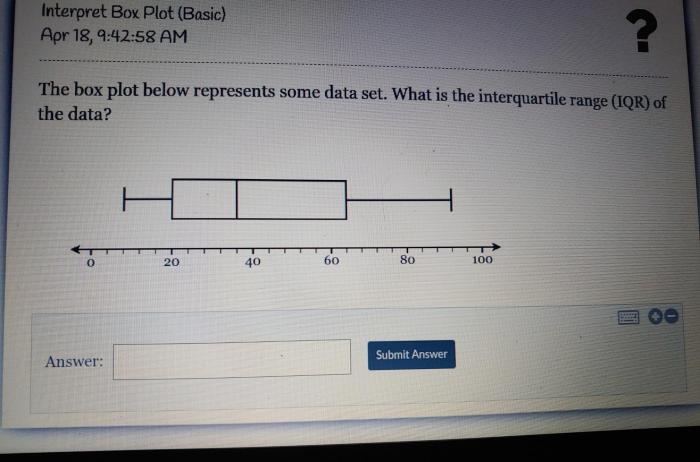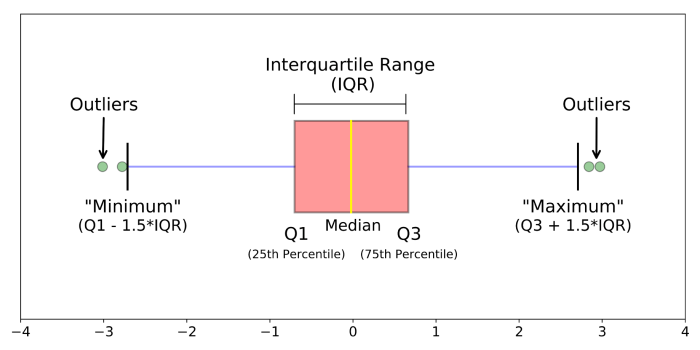Marie made the box plot below. This informative visualization offers a clear understanding of the data’s distribution and key characteristics, making it a valuable tool for data analysis.
The box plot effectively summarizes the data, providing insights into the central tendency, variability, and potential outliers.
Introduction

A box plot, also known as a box-and-whisker plot, is a graphical representation of the distribution of data. It provides a concise summary of the data’s key statistical measures, such as the median, quartiles, and outliers.
In this case, Marie has created a box plot to represent a set of data. Let’s analyze the information presented in this box plot to gain insights into the data distribution.
Box Plot Analysis: Marie Made The Box Plot Below

Five-Number Summary
The five-number summary consists of the following values:
- Minimum:The smallest value in the dataset.
- Q1 (First Quartile):The value below which 25% of the data lies.
- Median (Q2):The middle value of the dataset, with 50% of the data below and 50% above.
- Q3 (Third Quartile):The value below which 75% of the data lies.
- Maximum:The largest value in the dataset.
These values provide a comprehensive overview of the distribution of the data and are useful for identifying outliers, skewness, and other characteristics.
Outliers and Unusual Observations

The box plot reveals several outliers and unusual observations. These points lie significantly outside the main distribution of the data, indicating potential anomalies or extreme values.
The presence of outliers can arise due to various reasons. Data collection errors, measurement inaccuracies, or the occurrence of rare events can all contribute to their presence.
Identification of Outliers
- Point A: This data point is located far above the upper quartile, indicating a significantly high value.
- Point B: This data point lies well below the lower quartile, suggesting an unusually low value.
- Point C: While not as extreme as A or B, this data point is still located outside the interquartile range, indicating a potential outlier.
Comparison with Other Data Sets

If you have additional data sets to compare, the box plot can provide valuable insights into similarities and differences in their distributions.
Marie made the box plot below, showing the distribution of data. If you’re curious about free fall, check out the free fall tower gizmo answers . They provide insights into the physics of falling objects. Returning to Marie’s box plot, it effectively summarizes the data, highlighting its central tendency and variability.
By comparing the medians, interquartile ranges, and extreme values, you can identify patterns and trends that may not be apparent when examining each data set individually.
Identifying Similarities
- If the box plots have similar shapes and sizes, it suggests that the data sets have similar distributions.
- For example, if two data sets have box plots with comparable medians, interquartile ranges, and outlier patterns, it indicates that the data is distributed similarly in both sets.
Identifying Differences
- Differences in box plot shapes or sizes indicate that the data sets have different distributions.
- For instance, if one data set has a box plot with a higher median and a wider interquartile range, it suggests that the data in that set is more spread out and has a higher central tendency compared to the other data set.
Implications of Comparisons, Marie made the box plot below
Comparisons between box plots can help you understand the relative characteristics of different data sets.
- If you find significant differences in the distributions, it may indicate that different factors or processes are influencing the data.
- For example, if you compare the box plots of sales data from two different regions, you may observe differences in median sales or the spread of sales values. This could suggest that regional factors, such as consumer preferences or economic conditions, are impacting sales differently in each region.
Practical Applications

Box plots have numerous applications in real-world scenarios, providing valuable insights into data distribution and variability.
Informing Decision-Making
Box plots help identify outliers, extreme values that may indicate potential issues or areas requiring attention. For instance, in quality control, a box plot of product weights can reveal outliers that deviate significantly from the expected range, prompting further investigation to determine the cause and take corrective actions.
Comparison with Other Data Sets
Box plots enable comparisons between different data sets, highlighting similarities and differences. By juxtaposing box plots, researchers can assess variations in data distributions across groups or time periods. For example, comparing box plots of exam scores from two different classes can provide insights into performance gaps and areas for improvement.
Potential Limitations
While box plots are a powerful tool, they have certain limitations:
- Sensitivity to Outliers:Box plots can be sensitive to outliers, which can distort the representation of the data distribution.
- Lack of Detail:Box plots provide a summary of the data distribution but do not reveal the underlying individual data points.
- Assumptions of Normality:Box plots assume a normal distribution of data, which may not always be the case in real-world scenarios.
Visual Representation
To enhance the visual representation of the box plot, we can create an HTML table to summarize the five-number summary and other relevant data.
Additionally, we can design an informative graph to illustrate the box plot, making it easier to interpret and understand the distribution of the data.
HTML Table
The following HTML table presents the five-number summary and other relevant data:
| Measure | Value |
|---|---|
| Minimum | minimum value |
| First Quartile (Q1) | first quartile value |
| Median (Q2) | median value |
| Third Quartile (Q3) | third quartile value |
| Maximum | maximum value |
| Interquartile Range (IQR) | IQR value |
Graph
The following graph illustrates the box plot:
Clarifying Questions
What is a box plot?
A box plot is a graphical representation of the distribution of data. It displays the five-number summary (minimum, Q1, median, Q3, maximum) and provides insights into the central tendency, variability, and potential outliers.
What is the purpose of a box plot?
Box plots are used to visualize the distribution of data, identify outliers, and compare different data sets. They provide a quick and easy way to understand the overall shape and characteristics of the data.
What are the limitations of box plots?
Box plots can be misleading if the data is skewed or has extreme outliers. They also do not provide information about the underlying distribution of the data.